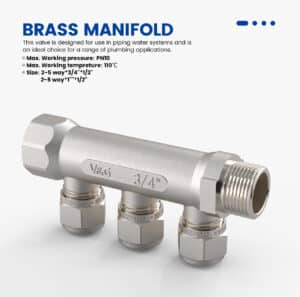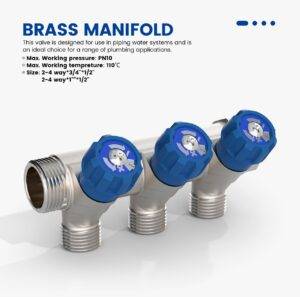In any fluid handling or instrumentation system, precision and efficiency are key. That’s where valve manifolds come in. These essential components streamline the control of fluid or gas flow, reduce leakage points and simplify maintenance tasks. Whether you work in industrial automation, oil and gas, chemical processing or HVAC systems, understanding valve manifolds and the different valve manifold types is crucial for building reliable and efficient systems.
In this guide, we’ll explore what valve manifolds do, why they matter and the various valve manifold types available. This knowledge can help you select the right manifold configuration for your application, improve system performance and reduce downtime.
What Is a Valve Manifold?
A valve manifold is a compact, integrated unit that houses multiple valves in a single block. These valves can control, isolate or divert the flow of gases and liquids within a system. Instead of installing several individual valves with multiple fittings and connections, a valve manifold combines them into a streamlined assembly. This design reduces the number of leak points and creates a neater, more organized piping system.
Valve manifolds are most commonly used with pressure transmitters, differential pressure gauges and flow meters. They allow operators to isolate, calibrate or vent instruments without shutting down the entire system. By offering multiple functions in one body, valve manifolds increase efficiency, enhance safety and make routine maintenance easier.
Why Use a Valve Manifold?
Valve manifolds bring several advantages that make them indispensable in complex fluid systems:
-
Space-Saving Design: Instead of using multiple valves and fittings spread across a panel or pipeline, it combines everything into one compact device. This helps especially in tight installations or confined equipment cabinets.
-
Improved Safety: Valve manifolds allow you to isolate instruments, vent pressure safely and perform maintenance without exposing workers to high-pressure lines or volatile fluids.
-
Reduced Leak Paths: Fewer connections mean fewer chances for leaks. A well-designed manifold can eliminate multiple fittings, each of which would otherwise be a potential weak point.
-
Simplified Installation and Maintenance: Manifolds simplify the layout, reduce installation time and make future servicing much easier. You can perform tasks like pressure testing or calibration without removing multiple components.
-
Enhanced Control: Whether it’s isolating a pressure transmitter or balancing pressure across a sensor, a valve manifold gives precise control over how fluids flow through the system.
Types of Valve Manifolds

Valve manifolds come in different configurations, depending on the number of valves and the specific purpose they serve. Here’s a breakdown of the most commonly used types:
1. 2-Valve Manifold
This is the simplest valve manifold type, often used with pressure gauges or static pressure transmitters. It features:
-
One isolation valve to block the process fluid from reaching the instrument.
-
One vent (or bleed) valve to release pressure safely from the instrument side.
With this configuration, technicians can isolate the instrument and depressurize it before maintenance or replacement. It’s ideal for low-complexity systems where only pressure monitoring is needed without the need to balance or equalize pressures.
2-Valve Block and Bleed Manifold
Similar to the standard 2-valve setup, the block and bleed version adds a bleed valve to the system to improve pressure control and safety. It is designed for static pressure applications, especially where trapped pressure could pose a hazard or lead to incorrect readings.
The block valve shuts off the process fluid and the bleed valve vents any trapped fluid from the instrument side. This configuration enhances safety and simplifies pressure gauge calibration or transmitter maintenance.
3-Valve Manifold
The 3-valve manifold is a common configuration for differential pressure transmitters. It includes:
-
Two isolation valves, one for the high-pressure side and one for the low-pressure side.
-
One equalizing valve to balance pressure between both sides of the transmitter.
This setup allows technicians to equalize pressure before starting or stopping a measurement. It also protects the instrument from sudden pressure changes and helps ensure accurate readings. By controlling high- and low-pressure lines, this makes differential pressure instruments easier to manage and maintain.
5-Valve Manifold
This more advanced version adds extra functionality for complex systems. A 5-valve manifold includes:
-
Two isolation valves (high and low side)
-
One equalizing valve
-
Two vent or test valves
The two vent valves allow pressure release from both the high- and low-pressure sides of the instrument. This design is used in systems where safe, precise venting and testing are critical. It provides maximum flexibility during calibration and maintenance, making it a popular choice for chemical plants, refineries and other high-performance industries.
Mono-Flange Manifold
A mono-flange manifold integrates multiple valve functions into one compact flange-mountable body. It typically includes isolation, bleed, and sometimes even test valves.
Mono-flange manifolds are ideal for offshore platforms, gas distribution skids, and compact instrumentation panels. Their streamlined design saves space, reduces the number of fittings and minimizes potential leak points, making them a reliable solution for tight installations and harsh environments.
Manifold Mounting Types
Valve manifolds can be mounted in different ways, depending on system layout and accessibility:
-
Direct Mount: It attaches directly to the instrument. This setup minimizes piping length and reduces vibration and leak risks. It’s commonly used in field-mounted transmitters.
-
Remote Mount: When direct access to the process line isn’t possible or when high temperatures make it unsafe, remote mounting allows it to sit away from the instrument, connected via impulse tubing.
-
Wall or Panel Mount: In control rooms or instrumentation panels, manifolds may be mounted on walls or inside enclosures. This setup is ideal for protected environments and easy access for maintenance.
Choosing the right mounting method ensures better safety, performance and serviceability of your fluid system.

Final Thoughts
Valve manifolds play a crucial role in modern fluid and gas systems. They improve safety, reduce installation time and enhance the precision and efficiency of pressure monitoring and control equipment. By integrating multiple valves into one compact unit, manifolds simplify both design and maintenance while reducing the potential for leaks and errors.
When selecting a valve manifold, always consider the application type, number of required valves, system pressure, material compatibility, and mounting style. Whether you’re using a basic 2-valve setup for pressure measurement or a complex 5-valve system for differential pressure transmitters, choosing the right configuration is essential for long-term reliability and performance.


